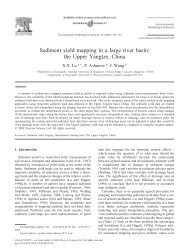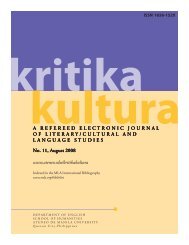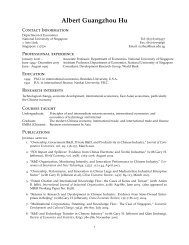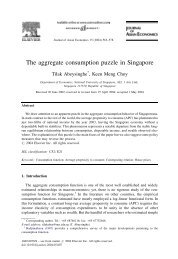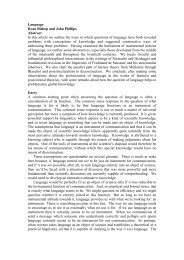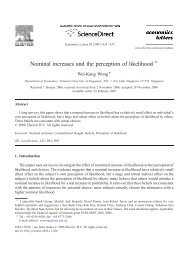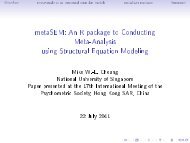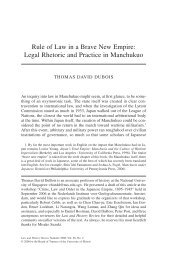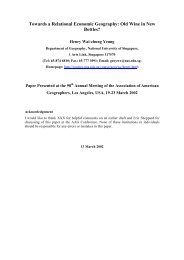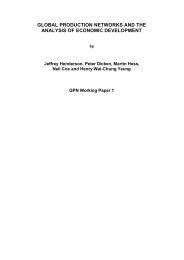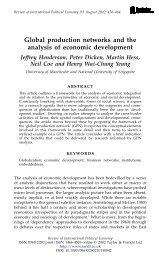Researching Hybridity in Social and Economic ... - NUS Home
Researching Hybridity in Social and Economic ... - NUS Home
Researching Hybridity in Social and Economic ... - NUS Home
Create successful ePaper yourself
Turn your PDF publications into a flip-book with our unique Google optimized e-Paper software.
how these non-Ch<strong>in</strong>ese actors are enrolled <strong>in</strong>to <strong>and</strong> shape “Ch<strong>in</strong>ese” bus<strong>in</strong>ess networks. On<br />
the domestic front, gatekeepers <strong>in</strong> home countries cont<strong>in</strong>ue to serve as vital <strong>in</strong>termediaries <strong>in</strong><br />
Ch<strong>in</strong>ese capitalism so that family firms can use their monopolistic licenses <strong>and</strong> special<br />
privileges to generate capital to susta<strong>in</strong> their transnational operations. These home country<br />
<strong>in</strong>termediaries <strong>in</strong> Ch<strong>in</strong>ese capitalism are typically government bureaucrats, politicians,<br />
<strong>in</strong>digenous bus<strong>in</strong>ess partners, <strong>and</strong> so on. Disentangl<strong>in</strong>g their complex enrollment <strong>in</strong>to<br />
“Ch<strong>in</strong>ese” bus<strong>in</strong>ess networks is aga<strong>in</strong> an important task <strong>in</strong> underst<strong>and</strong><strong>in</strong>g the nature <strong>and</strong><br />
organization of Ch<strong>in</strong>ese capitalism <strong>in</strong> East <strong>and</strong> Southeast Asia (see below for an example of<br />
Li Ka-sh<strong>in</strong>g’s Cheung Kong Hold<strong>in</strong>gs).<br />
<strong>Research<strong>in</strong>g</strong> <strong>in</strong>to the secrets of Ch<strong>in</strong>ese capitalism<br />
The Ch<strong>in</strong>ese capitalism example above shows that not only economic <strong>in</strong>stitutions are<br />
embedded <strong>in</strong> social relations, but also actors <strong>in</strong> these networks of relations have hybrid<br />
identities that are strongly <strong>in</strong>fluenced by their discursive <strong>and</strong> <strong>in</strong>stitutional contexts. Return<strong>in</strong>g<br />
to Figure 1, I argue that an <strong>in</strong>tegrated method approach is an appropriate methodology to<br />
unfold the secrets of Ch<strong>in</strong>ese capitalism. In this section, I aim to reflect on the methodological<br />
realities of my decade-long research <strong>in</strong>to Ch<strong>in</strong>ese capitalism. Start<strong>in</strong>g with the choice of<br />
empirical data, I knew at the beg<strong>in</strong>n<strong>in</strong>g of my research that an exclusive reliance on either<br />
primary data or secondary sources would be <strong>in</strong>sufficient to unfold the secrets of Ch<strong>in</strong>ese<br />
capitalism. Instead, I had to comb<strong>in</strong>e both data sources <strong>and</strong> triangulate their efficacy <strong>and</strong><br />
complementarity. For example, conduct<strong>in</strong>g large-scale surveys with such actors <strong>in</strong> Ch<strong>in</strong>ese<br />
capitalism as CEOs of family firms – a methodological approach much favoured <strong>in</strong> bus<strong>in</strong>ess<br />
school research (e.g. Tsang, 2002; Ahlstrom et al., 2004) – may be sufficient to generate some<br />
quantifiable establishment characteristics (e.g. firm size <strong>and</strong> employment) <strong>and</strong> statistical<br />
relationships on certa<strong>in</strong> dependent variables (e.g. family ownership <strong>and</strong> f<strong>in</strong>ancial<br />
performance). But it is not a mean<strong>in</strong>gful method to expla<strong>in</strong> the material <strong>and</strong> discursive<br />
17



